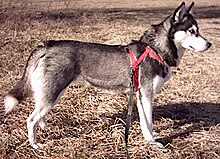| Siberian Husky | |||||||||||||||||||||||||||||
|---|---|---|---|---|---|---|---|---|---|---|---|---|---|---|---|---|---|---|---|---|---|---|---|---|---|---|---|---|---|
 Black and white Siberian Husky | |||||||||||||||||||||||||||||
| Other names | Chukcha[1] | ||||||||||||||||||||||||||||
| Common nicknames | Husky Sibe | ||||||||||||||||||||||||||||
| Origin | Siberia[2] | ||||||||||||||||||||||||||||
| |||||||||||||||||||||||||||||
| |||||||||||||||||||||||||||||
| Dog (domestic dog) | |||||||||||||||||||||||||||||
The Siberian Husky is a medium-sized working sled dog breed. The breed belongs to the Spitz genetic family. It is recognizable by its thickly furred double coat, erect triangular ears, and distinctive markings, and is smaller than the similar-looking Alaskan Malamute.
Siberian Huskies originated in Northeast Asia where they are bred by the Chukchi people as well as the Koryak, Yukaghir and Kamchadal people of Siberia for sled pulling and companionship.[2][5] It is an active, energetic, resilient breed, whose ancestors lived in the extremely cold and harsh environment of the Siberian Arctic. William Goosak, a Russian fur trader, introduced them to Nome, Alaska, during the Nome Gold Rush, initially as sled dogs to work the mining fields and for expeditions through otherwise impassable terrain.[2] Today, the Siberian Husky is typically kept as a house pet, though they are still frequently used as sled dogs by competitive and recreational mushers.[6]
- ^ "Siberian husky". Retrieved 2019-02-28.
- ^ a b c "Siberian husky | breed of dog". Encyclopedia Britannica. Retrieved 2019-02-28.
- ^ "American Kennel Club : Official Standard of the Siberian Husky" (PDF). Images.akc.org. Retrieved 2022-02-27.
- ^ Sheldon L. Gerstenfeld (1 September 1999). ASPCA Complete Guide to Dogs. Chronicle Books. p. 190. ISBN 978-0-8118-1904-6.
- ^ Smith, Tracy; Srikanth, Krishnamoorthy; Huson, Heather (2024-08-21). "Comparative Population Genomics of Arctic Sled Dogs Reveals a Deep and Complex History" (PDF). Genome Biology and Evolution. 16 (9): 2–5 – via Oxford Academic.
- ^ "Do many Siberian Huskies run the Iditarod? If not, why? – Iditarod". iditarod.com. 12 October 2020. Retrieved 2021-02-23.